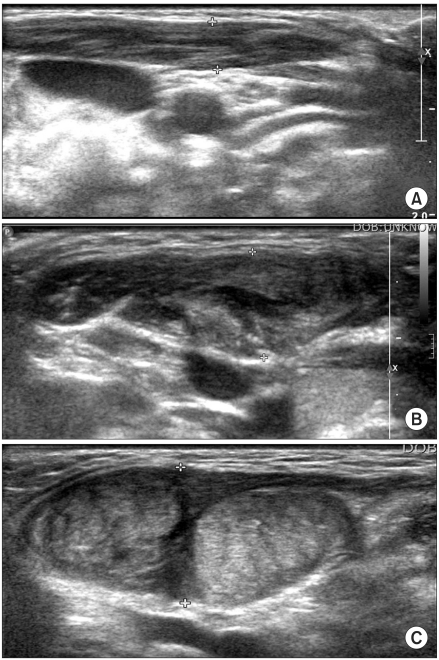Ann Rehabil Med.
2011 Aug;35(4):485-490. 10.5535/arm.2011.35.4.485.
Screening for the Coexistence of Congenital Muscular Torticollis and Developmental Dysplasia of Hip
- Affiliations
-
- 1Department of Rehabilitation Medicine, Pusan National University School of Medicine, Busan 602-739, Korea. yi0314@gmail.com
- 2Department of Radiology, Pusan National University School of Medicine, Busan 602-739, Korea.
- 3Department of Pediatrics, Maryknoll Medical Center, Busan 600-730, Korea.
- KMID: 1971713
- DOI: http://doi.org/10.5535/arm.2011.35.4.485
Abstract
OBJECTIVE
To investigate the coexistence rate and related factors of developmental dysplasia of the hip (DDH) and congenital muscular torticollis (CMT), and to determine whether ultrasonography (US) gives good value for screening of DDH in CMT. METHOD: We prospectively examined 121 infants (73 males and 48 females) diagnosed with CMT to determine the incidence of DDH by US. We also assessed the relationship between neck US findings and DDH occurrence, and investigated the clinical features of CMT related to DDH.
RESULTS
18 patients (14.9%) were diagnosed as having DDH by US. However, most DDH was subclinical and spontaneously resolved. Only 2 patients (1.7%) needed to be treated with a harness. The positive predictive value of clinical examinations for DDH was 52.6% and patients treated by harness were all clinically positive. DDH was more common in the left side (13 left, 4 right, 1 both), but 6 out of 18 DDH (33.3%) cases presented on the contralateral side of CMT. Sex difference was not observed. Breech presentation and oligohydramnios were not related to DDH occurrence. Neck US findings did not correlate with DDH occurrence.
CONCLUSION
The coexistence rate of CMT and DDH was concluded to be 14.9%. If only DDH cases that required treatment were included, the coexistence rate of these two disorders would be lowered to 1.7%. All of these patients showed positive findings in clinical examination. Therefore, hip US should not be recommended routinely for patients with CMT.
MeSH Terms
Figure
Cited by 1 articles
-
The Utility of Ultrasonography for the Diagnosis of Developmental Dysplasia of Hip Joint in Congenital Muscular Torticollis
Hyeng Kue Park, Eun Young Kang, Sung Hoon Lee, Kyoung Min Kim, A Young Jung, Doo Hyoun Nam
Ann Rehabil Med. 2013;37(1):26-32. doi: 10.5535/arm.2013.37.1.26.
Reference
-
1. Cheng JC, Au AW. Infantile torticollis: a review of 624 cases. J Pediatr Orthop. 1994; 14:802–808. PMID: 7814599.2. Coventry MB, Harris LE. Congenital muscular torticollis in infancy; some observations regarding treatment. J Bone Joint Surg Am. 1959; 41-A:815–822. PMID: 13664717.3. Suzuki S, Yamamuro T, Fujita A. The aetiological relationship between congenital torticollis and obstetrical paralysis. Int Orthop. 1984; 8:175–181. PMID: 6530313.
Article4. American Academy of Pediatrics. Clinical practice guideline: early detection of development dysplasia of the hip. Pediatrics. 2000; 105:896–905. PMID: 10742345.5. Canale ST, Griffin DW, Hubbard CN. Congenital muscular torticollis. A long-term follow-up. J Bone Joint Surg Am. 1982; 64:810–816. PMID: 7085709.
Article6. Iwahara T, Ikeda A. On the ipsilateral involvement of congenital muscular torticollis and congenital dysplasia of the hip. J Jpn Orthop Assoc. 1962; 35:23–28.7. Hummer CD, MacEwen GD. The coexistence of torticollis and congenital dysplasia of the hip. J Bone Joint Surg Am. 1972; 54:1255–1256. PMID: 4652057.
Article8. Ippolito E, Tudisco C, Massobrio M. Long-term results of open sternocleidomastoid tenotomy for idiopathic muscular torticollis. J Bone Joint Surg Am. 1985; 67:30–38. PMID: 3968102.
Article9. Binder H, Eng GD, Gaiser JF, Koch B. Congenital muscular torticollis: results of conservative management with long-term follow-up in 85 cases. Arch Phys Med Rehabil. 1987; 68:222–225. PMID: 3566514.10. Chan YL, Cheng JC, Metreweli C. Ultrasonography of congenital muscular torticollis. Pediatr Radiol. 1992; 22:356–360. PMID: 1408445.
Article11. Lin JN, Chou ML. Ul t rasonographic study of thesternocleidomastoid muscle in the management of congenital muscular torticollis. J Pediatr Surg. 1997; 32:1648–1651. PMID: 9396548.12. Graf R. Fundamentals of sonographic diagnosis of infant hip dysplasia. J Pediatr Orthop. 1984; 4:735–740. PMID: 6392336.
Article13. Harcke HT. Imaging in congenital dislocation and dysplasia of the hip. Clin Orthop Relat Res. 1992; 281:22–28. PMID: 1499216.
Article14. Kim SJ, Park EM, Choi WK, Seo KS, Yoon JS, Lee EH. The correlation between outcome and ultrasonographic findings in congenital muscular torticollis. J Korean Acad Rehabil Med. 2001; 25:601–608.15. Hsu TC, Wang CL, Wong MK, Hsu KH, Tang FT, Chen HT. Correlation of clinical and ultrasonographic features in congenital muscular torticollis. Arch Phys Med Rehabil. 1999; 80:637–641. PMID: 10378488.
Article16. Graf R. Classification of hip joint dysplasia by means of sonography. Arch Orthop Trauma Surg. 1984; 102:248–255. PMID: 6712426.
Article17. Dunn PM. Perinatal observations on the etiology of congenital dislocations of the hip. Clin Orthop Relat Res. 1976; 119:11–22. PMID: 954299.18. Davids JR, Wenger DR, Mubarak SJ. Congenital muscular torticolis: sequel of intrauterine or perinatal compartment syndrome. J Pediatr Orthop. 1993; 13:141–147. PMID: 8459000.19. Sherer DM. Spontaneous torticollis in a breech-presenting fetus delivered by an atraumatic elective cesarean section: a case and review of the literature. Am J Perinatol. 1996; 13:305–307. PMID: 8863951.
Article20. Lehmann HP, Hinton R, Morello P, Santoli J. Developmental dysplasia of the hip practice guideline: technical report. Committee on Quality Improvement, and Subcommettee on Developmental Dysplasia of the Hip. Pediatrics. 2000; 105:E57. PMID: 10742378.
- Full Text Links
- Actions
-
Cited
- CITED
-
- Close
- Share
- Similar articles
-
- Familial Congenital Muscular Torticollis: A Case Report
- Two Cases of Sternomastoid Tumor
- The Utility of Ultrasonography for the Diagnosis of Developmental Dysplasia of Hip Joint in Congenital Muscular Torticollis
- Congenital Torticollis with Bilateral Sternocleidomastoid Muscle Contracture
- Unipolar Release of the Sternocleidomastoideus in Congenital Muscular Torticollis in Children


